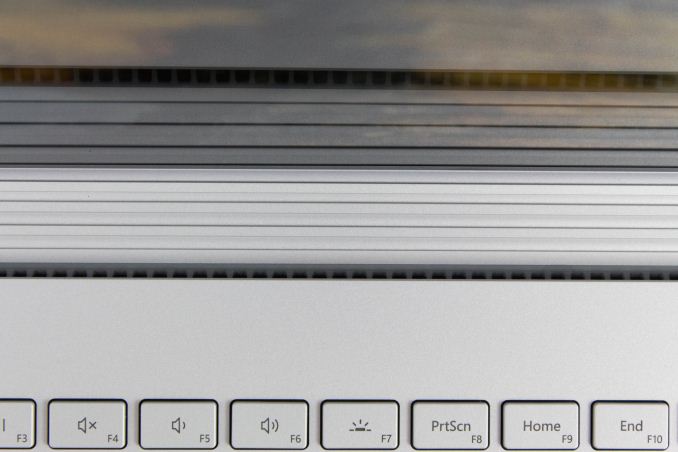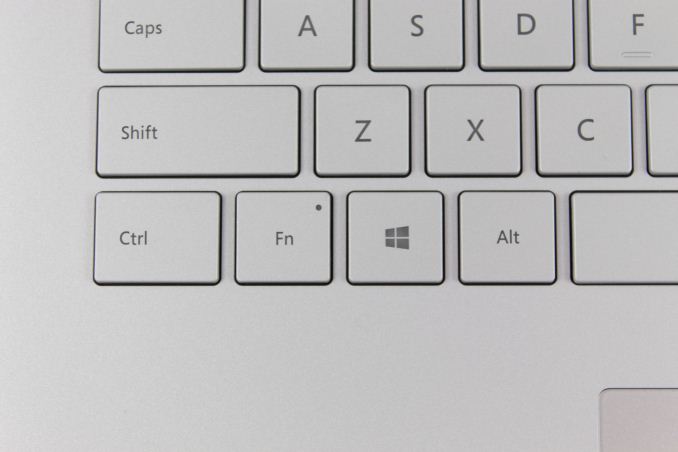The Microsoft Surface Book 2 (15-Inch) Review: Second Time's The Charm
by Brett Howse on December 21, 2017 8:00 AM EST- Posted in
- Laptops
- Microsoft
- Surface
- Pascal
- Surface Book
- Kaby Lake Refresh
Design
When the Surface Book launched, it offered a lot of innovative ideas in the laptop space, and none more innovative than separating the CPU, RAM, and storage into the display section, which is removable, and the GPU and majority of the battery into the base. It allowed Microsoft to pack in more battery than most other laptops at the time. To avoid the usual top-heavy feel of most laptops with a detachable display, Microsoft created an interesting hinge design, which rolls out when opening the display, making the base slightly longer and giving it more leverage. That hinge has returned, and keeps the Surface Book 2 looking like a Surface Book. Not everyone loved the hinge design, but it does work well and gives the Surface Book lineup a design touch that is instantly recognizable. The hinge doesn’t let the display lay flat, but it has to balance the weight of the display versus the requirements of opening the display all the way, which is somewhat negated by being able to detach the display if necessary.
The tablet section is not something you could use as a tablet full-time. At 15-inches in size, it’s a bit unwieldy, which was already an issue with the smaller 13.5-inch model. The squared off edges look great, but don’t help much with in-hand feel of the large tablet. With the relatively small battery capacity, the overall weight of the tablet is light enough that it’s easy to use in short bursts, but short bursts are all you’ll get out of it anyway before the battery needs to be replenished. Just like the original, it offers a satisfying “kerchunk” when detaching from the base.
The base is almost a carbon-copy of the Surface Book with Performance Base mid-cycle upgrade model. The keyboard is slightly raised to give more room for the GPU and cooling components under it. Other than the USB-C port, the new base looks identical to the older version, keeping the two USB-A ports on the left, along with the SD card reader, and offering the Surface Connect port and USB-C on the right.
The keyboard on the original Surface Book was one of the better models available on a laptop, offering good travel, and good key feel. Luckily it hasn’t really changed, and still offers three levels of white backlighting, and thanks to the gray color of the keys, the white backlighting still offers decent contrast even when in a bright environment.
Microsoft offered the best trackpad experience on a Windows PC with the original Surface Book, and that great precision and feel of the glass trackpad carries over with the new model. The trackpad is large, but without being too large, and the latest Precision touchpad software offers plenty of customization for gestures and more. It’s wonderful to use, and makes you miss it when using an inferior device.
Microsoft’s gray magnesium design has become something they are known for, even if not all of the devices are magnesium anymore, but on the Surface Book 2, the texture and feel of the material is as premium as any device on the market. The chassis has a chamfered edge in front of the trackpad to allow you to open it easier, and although the rest of the edges are more acute, they still have a slightly rounded corner to prevent sharp pressure on your wrists when typing. Thanks to the 3:2 aspect ratio of the display, the Surface Book lineup also offers more wrist rest area than most other notebooks.
Overall the design of the Surface Book 2 is fantastic, which is becoming an expectation when dealing with the PC products from Redmond. The only small thing to point out would be the location of the headphone jack, which is on the top right corner of the display, making for a somewhat awkward cable arrangement when using wired headphones. It would be nice to see a second jack in the base, to be used while the laptop is being used as a laptop, but that seems like a small thing to complain about on an otherwise very well designed and built device.













120 Comments
View All Comments
Peskarik - Thursday, December 21, 2017 - link
One BIG problem with all these contemporary thin machines is the built-in battery.First of all, the full charge capacity is always lower than the announced capacity (battery is like a human, ages right from the birth).
Secondly, battery looses capacity over the charging cycles, especially if one does 0-100% charges.
So, a year from purchase one does not have 85Wh anymore, most likely having lost 20% of that. And what do you do then? Replacing the battery, if even possible, is very expensive outlay (I suppose, I haven't done it yet, but only because I still use Thinkpad with fully replaceable battery).
zepi - Thursday, December 21, 2017 - link
Ageing of batteries is usually overblown if they are managed properly.For example my wife has a 3 years old Macbook Pro with close to 800 cycles on the battery and it still holds 85% of the original charge. Obviously there is degradation, but her usage is super hard, doing 100 to 0% deep discharges day in day out etc, despite my warnings that this is bad for the battery. This more or less aligns with my own experiences with other "unibody" Macbook Pro's that I've used over the years.
Despite having used macs with integrated batteries for about 10 years, I've never experienced one losing so much battery degradation that I would have even considered replacing a battery, with my wife's example being the worst.
Are PC laptops considerably worse in this regards? Normally 1000 cycles loses at most 20% of battery life and for modern laptops that is from 10h to 8 hours, which I don't think is such a disaster.
mkozakewich - Thursday, December 21, 2017 - link
I just ran a battery report, and my Surface Book 2 has got 109% battery health.Good companies know things will degrade a little, and they deal with it in a multitude of ways. My original Surface Pro still has about 80% of its battery after five years, and I expect the same from this.
Also, I get through a ten-hour day with nearly half my charge left, so I'll be perfectly fine with 20% less.
lucam - Thursday, December 21, 2017 - link
When the IPad Pro 2 review? .if is still part of your plans? Or will you wait till April by the time we gonna get the IPad Pro 2018?Ryan Smith - Thursday, December 21, 2017 - link
It's not on the schedule at this time.amdwilliam1985 - Thursday, December 21, 2017 - link
Here's a review for the iPad Pro 2.Best iPad [Pro] ever, buy it!
Merry Christmas :)
lucam - Friday, December 22, 2017 - link
Thank you...suppose same for iPhone X...merry xmas to you too..😁id4andrei - Friday, December 22, 2017 - link
Nope. The iphone X is starting to throttle down performance from the moment you buy it so it's a flawed device.lucam - Friday, December 22, 2017 - link
must be the reason why it hasn't been reviewed (here)...too hard to admit that...akdj - Sunday, December 31, 2017 - link
I’m completely with you lucam, 100%.Out of boredom, I read this one. We’re still ‘owed’ an A10 ‘deep dive’, haven’t seen a word on the updated (2 yrs ago) MacBook Pro, Apple Watch, iPhone or iPad.
Far cry from the ATech of old. I’m rarely here any more, all MoBo & power supply reviews makes for an extremely dull website to Ars veee go